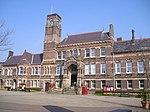Church of St Mary, Lowe House
1929 establishments in England20th-century Roman Catholic church buildings in the United KingdomChurch buildings with domesChurches in St. Helens, MerseysideEngvarB from September 2019 ... and 5 more
Grade II listed Roman Catholic churches in EnglandGrade II listed churches in MerseysideRoman Catholic churches completed in 1929Roman Catholic churches in MerseysideRomanesque Revival church buildings in England

The Church of St Mary, Lowe House is a Roman Catholic Parish church situated on North Road in St Helens, Merseyside. The present church was founded in 1924 and staffed by the Society of Jesus until 1981. It is a Grade II listed building with Romanesque and Gothic features.
Excerpt from the Wikipedia article Church of St Mary, Lowe House (License: CC BY-SA 3.0, Authors, Images).Church of St Mary, Lowe House
Crab Street,
Geographical coordinates (GPS) Address External links Nearby Places Show on map
Geographical coordinates (GPS)
| Latitude | Longitude |
|---|---|
| N 53.4571 ° | E -2.7404 ° |
Address
St Mary, Lowe House
Crab Street
WA10 2BE , Green Bank
England, United Kingdom
Open on Google Maps











